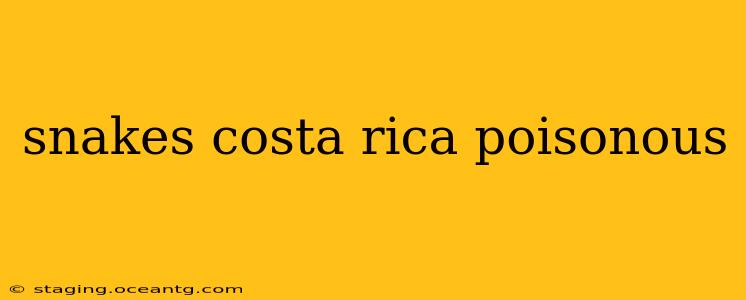Costa Rica, a land of incredible biodiversity, boasts a fascinating array of snake species. While many are harmless, some are venomous and pose a potential threat. Understanding which snakes are poisonous (venomous) and how to avoid them is crucial for anyone visiting or living in this beautiful country. This guide will delve into the poisonous snakes of Costa Rica, helping you identify them and learn how to stay safe.
What are the most common poisonous snakes in Costa Rica?
Several venomous snake species call Costa Rica home. Among the most frequently encountered are:
-
Fer-de-lance ( Bothrops asper): This large, terrestrial pit viper is arguably the most dangerous snake in Costa Rica. Its venom is hemotoxic, causing severe tissue damage, bleeding, and potentially death. They are adaptable and found in a wide range of habitats.
-
Bushmaster (Lachesis muta): The largest venomous snake in the Americas, the bushmaster is a formidable creature. Its potent neurotoxic venom can be fatal if left untreated. They are less frequently encountered than fer-de-lance due to their nocturnal habits and preference for undisturbed rainforest.
-
Central American rattlesnake (Crotalus simus): As its name suggests, this pit viper possesses rattles, warning potential threats of its presence. Its venom is also hemotoxic, causing similar effects to the fer-de-lance.
-
Coral snakes (Micrurus): While less aggressive than pit vipers, coral snakes are highly venomous. Their venom is neurotoxic and can cause paralysis and respiratory failure. Identifying coral snakes accurately is crucial, as they are often confused with harmless mimics.
How can I identify poisonous snakes in Costa Rica?
Identifying poisonous snakes requires careful observation and a good understanding of their characteristics. While there are exceptions, some key features can help you distinguish venomous snakes from non-venomous ones:
-
Heat-sensing pits: Many pit vipers (like fer-de-lance and rattlesnakes) possess heat-sensing pits located between their eyes and nostrils. These pits allow them to detect warm-blooded prey.
-
Triangular head: Many venomous snakes, particularly pit vipers, have a distinctly triangular-shaped head. This is due to the presence of large venom glands.
-
Rattles: Rattlesnakes are easily identifiable by their characteristic rattles at the end of their tails.
-
Color patterns: While color patterns can be variable, venomous snakes often have bold and distinctive markings. This can be helpful but is not a reliable identification method alone. Never rely solely on color to identify a snake.
-
Pupil shape: While not always definitive, many venomous snakes have elliptical pupils, whereas non-venomous snakes often have round pupils.
Caution: Do not attempt to handle or approach any snake you suspect to be venomous.
What should I do if I see a poisonous snake in Costa Rica?
The best course of action when encountering a venomous snake is to leave it alone and back away slowly. Avoid sudden movements that might startle the snake. Notify local authorities or park rangers if you are in a protected area.
What should I do if I am bitten by a poisonous snake in Costa Rica?
A snakebite is a medical emergency. Follow these steps:
- Stay calm: Panic will only accelerate your heart rate and spread the venom faster.
- Immobilize the limb: Keep the bitten area still to prevent the venom from spreading.
- Remove any jewelry or tight clothing: Swelling can occur rapidly.
- Seek immediate medical attention: Get to the nearest hospital or clinic as quickly as possible. It is crucial to have access to antivenom.
Are there any specific areas in Costa Rica with a higher concentration of poisonous snakes?
Poisonous snakes can be found throughout Costa Rica, but certain areas with lush vegetation, dense forests, and proximity to water sources tend to have higher populations. These include national parks and rainforests.
How common are snakebites in Costa Rica?
While snakebites do occur, they are relatively uncommon, particularly for tourists who exercise caution. Most bites result from accidental encounters, often when people inadvertently step on or disturb a snake.
What is the best way to prevent snake bites in Costa Rica?
Preventing snake bites requires awareness and preventative measures:
- Wear appropriate footwear: Avoid walking barefoot, especially in areas with tall grass or dense vegetation.
- Stick to marked trails: Stay on designated paths when hiking or exploring in the wild.
- Be cautious at night: Many snakes are nocturnal.
- Check your surroundings: Before reaching into crevices or under rocks, be sure there are no snakes hiding.
- Avoid handling snakes: Never attempt to handle any snake, even if it appears harmless.
By understanding the venomous snakes of Costa Rica and practicing caution, you can significantly reduce your risk of encountering a dangerous situation and enjoy the wonders of this incredible country safely. Remember, responsible wildlife viewing means observing from a safe distance and respecting the animals' natural habitat.
